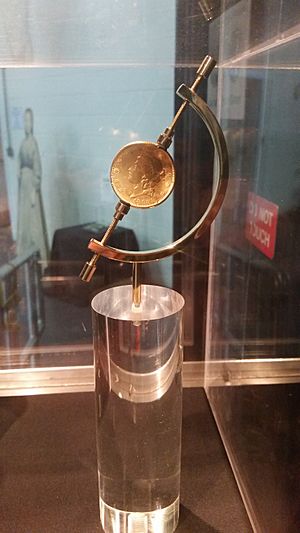George E. Dixon facts for kids
George Erasmus Dixon (born around 1837 – died February 17, 1864) was a soldier in the Confederate States Army during the American Civil War. He is most famous for being the commander of the Confederate submarine H.L. Hunley. He led the submarine on its successful mission to sink the Union ship USS Housatonic near Charleston, South Carolina.
Contents
Dixon's Early Life and Military Service
We don't know much about George Dixon's early life. Records from 1860 show he was about 23 years old and might have been from Kentucky or South Carolina. He worked as an engineer on steamboats and lived in New Orleans, Louisiana, before moving to Mobile, Alabama. His fancy uniform and jewelry found later suggest he was a wealthy man.
Dixon was part of a group called the Masons. He was a member of a lodge in Mobile.
In 1861, Dixon joined a military group called the Washington Light Infantry of Mobile. This group later became part of the 21st Alabama Infantry Regiment. Dixon started as a sergeant and was later promoted to lieutenant.
The Battle of Shiloh
In March 1862, Dixon's regiment went to Corinth, Mississippi. The next month, they fought in the Battle of Shiloh. This was a very tough battle where many soldiers were hurt or killed. Dixon himself was badly wounded in his left leg.
Luckily, a $20 gold coin he carried as a good luck charm saved his leg, and possibly his life! The bullet hit the coin, which absorbed much of the impact. However, his leg bone was still seriously damaged, and Dixon walked with a limp for the rest of his life.
After the battle, his regiment went back to Mobile to defend the city. During this time, Dixon became very interested in a new submarine that Horace Lawson Hunley was building.
The Final Mission of the Hunley
On February 17, 1864, Dixon commanded the Confederate submarine H.L. Hunley on its first and only attack against the Union Navy. He succeeded in sinking his target, the USS Housatonic.
However, the explosion from the submarine's torpedo was very close. It damaged the Hunley, causing it to sink as it tried to return to shore. Dixon and all seven of his crewmen died.
Finding the Hunley and Dixon's Remains
The H.L. Hunley submarine was found and brought up from the ocean in 2000. Dixon's remains were identified among the crew. His old Masonic lodge and other Masonic groups took part in the funeral for the crewmen. They were buried on April 17, 2004, in Magnolia Cemetery in Charleston, South Carolina.
The Gold Coin Legend
For over a hundred years, a romantic story has been told about George Dixon and his gold coin. The story says that Dixon's sweetheart, Queenie Bennett, gave him the coin. She asked him to carry it for good luck and as a sign of her love. Dixon always kept the coin with him.
At the Battle of Shiloh on April 6, 1862, Dixon was shot in his upper leg. When he checked his wound, he found that the bullet had hit the gold coin right in the middle. The coin was bent, but it saved his leg by taking most of the bullet's force.
Verifying the Story
When the H.L. Hunley was recovered, the story was partly proven true. The gold coin was found with Dixon's remains! Scientists studied Dixon's skull and found that a photo Queenie Bennett's family thought was Dixon was actually not him.
The coin itself doesn't mention Queenie Bennett. However, it does confirm that it stopped a bullet at Shiloh. The $20 gold coin was made in 1860 and is clearly bent from the bullet's impact. Both the coin and a wound on Dixon's leg bone had traces of lead from the bullet.
The back of the coin has four short lines carved into it: Shiloh April 6, 1862 My life Preserver G. E. D.
Other old letters also support the story. James M. Williams, who was Dixon's close friend and fought with him, wrote to his wife the day after the Battle of Shiloh: "George Dixon, shot in the hip, the ball striking a gold piece ranged upwards and came out of his side; will probably recover if he can be well cared for..."
This letter was published in a book about Civil War letters. James Williams even named his first son George Dixon Williams, showing how close they were.
The damaged gold coin is now on display. You can see it with other items and the Hunley submarine itself at the Warren Lasch Conservation Center.


